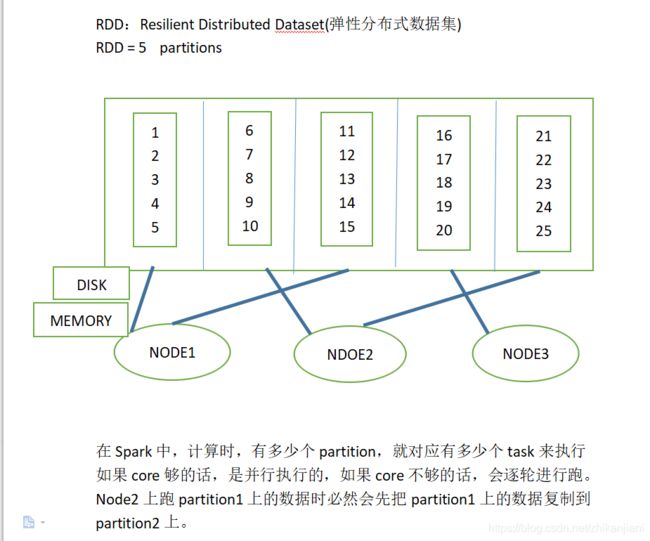若泽数据B站视频Spark03 - RDD深入讲解
一、什么是RDD
二、RDD的源码定义
三、RDD五大特性详解
四、RDD五大特性和源码的对应关系
五、图解RDD
视频来源:若泽数据
链接:https://pan.baidu.com/s/1yWomjC3SAWDT8eh3ZX73pA
提取码:papt
楼主QQ:2032677340
一、什么是RDD
RDD:Resilent Distributed Dataset,弹性分布式数据集,是Spark中最基本的数据抽象(the basic abstraction in spark)。
作用:让开发者大大降低开发分布式应用程序的门槛以及提高执行效率。
RDD源码查看地址:
- https://github.com/apache/spark/blob/master/core/src/main/scala/org/apache/spark/rdd/RDD.scala
Resilent Distributed Dataset:
1、Distributed Dataset 分布式数据集,数据归属在大的机器上,以分区的形式
2、Resilent(弹性怎么理解呢)弹性体现在它的计算之上。
弹性指的是RDD可以做到在分布式计算中容错,
比如:某个节点挂了,某个部分的数据丢失了,
能够通过某些机制进行修复,这个是体现在它计算中的Resilent(弹性)。
Distributed也意味着数据可以存储在不同的节点之上。
Dataset(数据集):可以理解为HDFS中的block、一个文件就是一个Dataset、一个数据结构就是一个数组。
-
Represents an immutable, 代表了一个不可变得==> val修饰
意味着我们的RDD一旦产生就是不可变得,RDDA==>RDDB;RDDB必然是一个新的。 -
partitioned collection of elements RDD中的元素能够被分区,理解为HDFS中的block、MapReduce中的split
-
that can be operated on in parallel. RDD中的元素能够以一种并行的方式被操作。
假设RDDA当中的元素有三个分区:一个RDD元素被拆分成了几块,每一块都在不同节点上存储
Hadoop001:Partition1、(1,2,3)
Hadoop002:Partition2、(4,5,6)
Hadoop003:Partition3、(7,8,9)
假设我们对这个RDDA执行了一个“+1”的操作,operated +1,三个分区分别存放在不同的机器上,operated + 1:是同时对这三个分区进行操作的。
输出:
Hadoop001:Partition1、(2,3,4)
Hadoop002:Partition2、(5,6,7)
Hadoop003:Partition3、(8,9,10)
二、RDD的源码定义:
abstract class RDD[T: ClassTag](
@transient private var _sc: SparkContext,
@transient private var deps: Seq[Dependency[_]]
) extends Serializable with Logging {
解释:
- 抽象类 RDD不能直接new,必然是有子类实现的,我们使用时直接用其子类即可;如下是JdbcRDD,都是继承自RDD类
class JdbcRDD[T: ClassTag](
sc: SparkContext,
getConnection: () => Connection,
sql: String,
lowerBound: Long,
upperBound: Long,
numPartitions: Int,
mapRow: (ResultSet) => T = JdbcRDD.resultSetToObjectArray _)
extends RDD[T](sc, Nil) with Logging {
- 序列化Serializable 网络的传输
- logging 记录日志的,在spark1.6中是能直接使用的,在spark2.0以后被移除了。
- T 泛型,支持字符串,自定义类型
- sparkContext
- @transient
三、RDD中五大特性
Internally, each RDD is characterized by five main properties:
1、A list of partitions
- RDD是由一系列的分区所构成的
2、A function for computing each split
- 举例:+ 1操作就是对所有分区都进行的
3、A list of dependencies on other RDDs
- RDDA --> RDDB --> RDDC --> RDDD,每一个分区间都有依赖关系
4、Optionally, a Partitioner for key-value RDDs (e.g. to say that the RDD is hash-partitioned)
5、Optionally, a list of preferred locations to compute each split on (e.g. block locations for
an HDFS file)
- 相当于是一个数据本地性的概念:你的数据在哪,就把task放到哪去执行,这样就省去了网络传输。
小结:
- 在信息爆炸的今天,单台机器的配置再怎么高,也是应付不了大规模的数据处理的;所以我们在计算的时候也要选择分布式,在数据存储的时候要进行分割,并且以多副本的方式进行保存,此举便于容错。计算的时候也要进行切分,以一个task去处理2个block。传统的分布式存储(HDFS)+分布式计算(MapReduce)
四、RDD五大特性和源码的对应关系
源码网址:
- https://github.com/apache/spark/blob/master/core/src/main/scala/org/apache/spark/rdd/RDD.scala
- def compute(split: Partition, context: TaskContext): Iterator[T] ==>对应RDD的第二个特性,做计算就是对RDD中的分区做计算。计算方法传入参数肯定有Partition,后面是上下文;
Q:coumpute传入的参数有哪些
-
protected def getPartitions: Array[Partition] 一个RDD是由一系列的分区构成,那他返回的必然是一个数组或集合,集合中存放类型必然是partition ==>对应RDD中第一个特性 a list of partitions
-
protected def getDependencies: Seq[Dependency[_]] = deps //因为RDD中是有转换的,每一个都有对应关系。
-
protected def getPreferredLocations(split: Partition): Seq[String] = Nil 有一个方法叫getPreferredLocations,得到最优先的位置,返回的是一个数组或集合的东西,==>对应RDD第五个特点
-
@transient val partitioner: Option[Partitioner] = None //以键值对方式(key,value)的时候有一个partitioner, ==>对应第四大特点。
打开JdbcRDD.scala
override def getPartitions: Array[Partition] = {
// bounds are inclusive, hence the + 1 here and - 1 on end
val length = BigInt(1) + upperBound - lowerBound
(0 until numPartitions).map { i =>
val start = lowerBound + ((i * length) / numPartitions)
val end = lowerBound + (((i + 1) * length) / numPartitions) - 1
new JdbcPartition(i, start.toLong, end.toLong)
}.toArray
} //获取到分区信息,操作JDBC的方式,代码中有一个起始和结束位置,eg:有10个分区,10000调数据,每个分区处理数据都有对应顺序,比如第一个分区处理第1~1000条数据,第二个分区处理1001~2000的数据。
每个分区做一个map,开始和结束构建出来一个JdbcParttion,就能得到partitions.
2、标准的Jdbc编程
override def compute(thePart: Partition, context: TaskContext): Iterator[T] = new NextIterator[T]
{
context.addTaskCompletionListener[Unit]{ context => closeIfNeeded() }
val part = thePart.asInstanceOf[JdbcPartition]
val conn = getConnection()
val stmt = conn.prepareStatement(sql, ResultSet.TYPE_FORWARD_ONLY, ResultSet.CONCUR_READ_ONLY)
val url = conn.getMetaData.getURL
if (url.startsWith("jdbc:mysql:")) {
// setFetchSize(Integer.MIN_VALUE) is a mysql driver specific way to force
// streaming results, rather than pulling entire resultset into memory.
// See the below URL
// dev.mysql.com/doc/connector-j/5.1/en/connector-j-reference-implementation-notes.html
stmt.setFetchSize(Integer.MIN_VALUE)
} else {
stmt.setFetchSize(100)
}
logInfo(s"statement fetch size set to: ${stmt.getFetchSize}")
stmt.setLong(1, part.lower)
stmt.setLong(2, part.upper)
val rs = stmt.executeQuery()
override def getNext(): T = {
if (rs.next()) {
mapRow(rs)
} else {
finished = true
null.asInstanceOf[T]
}
}
override def close() {
try {
if (null != rs) {
rs.close()
}
} catch {
case e: Exception => logWarning("Exception closing resultset", e)
}
try {
if (null != stmt) {
stmt.close()
}
} catch {
case e: Exception => logWarning("Exception closing statement", e)
}
try {
if (null != conn) {
conn.close()
}
logInfo("closed connection")
} catch {
case e: Exception => logWarning("Exception closing connection", e)
}
}
}
}
3、HadoopRDD.scala(读取hadoop文件的)
override def getPartitions: Array[Partition] = {
val jobConf = getJobConf()
// add the credentials here as this can be called before SparkContext initialized
SparkHadoopUtil.get.addCredentials(jobConf)
try {
val allInputSplits = getInputFormat(jobConf).getSplits(jobConf, minPartitions)
val inputSplits = if (ignoreEmptySplits) {
allInputSplits.filter(_.getLength > 0)
} else {
allInputSplits
}
val array = new Array[Partition](inputSplits.size)
for (i <- 0 until inputSplits.size) {
array(i) = new HadoopPartition(id, i, inputSplits(i))
}
array
//读文件借助于inputformat,对于RDD来说,inputformat.getsplits,拿到一堆inputsplits,partition大小就是inputsplits大小,构建一个数组,每个数组传一个partition,数组大小就是inptsplits.size;迭代inputsplits,每个构建hadoopPartition。
四、图解RDD
解释:如下图RDD有5个分区构成,每个分区中有5个元素;只有三台机器:hadoop001、hadoop002、hadoop003,分区分别存在于这三台机器上;数据既有可能存放在disk上也有可能存放在memory上,由于多副本策略,也有可能一个分区存多份
此时有5个分区,必然会启5个task,如果core够的话,5个task必然会是并行着执行的;core不够的话,会先跑完一轮再跑下一轮。
eg:partition的数据分布在各个节点之上,如果在hadoop002上运行partition1,需要先把partition1的数据复制到hadoop002上才能够做相应的计算,体现的是数据的本地性操作。

四、RDD的五大特性
Resilent Distributed Dataset(弹性分布式数据集)
Internally,each RDD is characterized by five main properties:
1) A list of partitions 它由很多个分区构成
2) A function for computing each split 对rdd进行+1的操作就是对每个分区做一个相同的function
3)A list of dependencies on other RDDs
举例:RDDA=>RDDB=>RDDC=>RDDD RDD和RDD之间都是有依赖关系的
这是一个流水线式的依赖关系,当某个分区数据丢失,spark会对某一个分区进行计算,前提是窄依赖。
4)optionally, A Partitioner for key-value RDDs(e.g to say that the RDD is hash-partitioned)
类似于MapReduce中按照key-hash进行分发,kafka中数据倾斜的话会把null的值放在一个中去。
5)optionally, a list of preferred locations to compute each split on (eg. block locations on an HDFS file)
数据本地性,数据在哪,需要把task分配到他所在的数据位置
作业执行的时候是以task的方式运行的,作业是以task完成最慢时间来决定的,木桶原理。
任何一个存储必然需要分布式,所以数据存储是需要切分的,以多副本的方式存储便于容错,计算的时候也需要切分,默认是block大小,相当于一个task去处理两个blocksize。
hdfs+mapreduce==>spark
五、RDD五大特性在源码中的体现
1、def compute(split: Partition, context: TaskContext): Iterator[T]
2、protected def getPartitions: Array[Partition]
一个RDD是由若干个集合、分区构成,它返回类型必然是一个数组、集合。这个方法对应RDD的方法中是1。
3、protected def getDependencies: Seq[Dependency[_]] = deps
对应关系==>RDD中的第三个特性
4、protected def getPreferredLocations(split: Partition): Seq[String] = Nil
它要计算split和location,
5、Optionally overridden by subclasses to specify how they are partitioned(可选地由子类重写,以指定如何分区)
@transient val partitioner: Option[Partitioner] = None
key-value 键值对
再看一个hadoopRDD.scala方法: